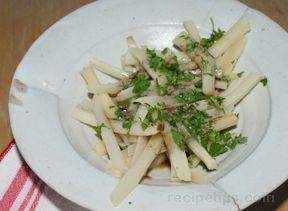White Salsify has a light grey or light tan colored skin with tiny hair-like rootlets or branches extending from the base of the root. Appearing much like a short, odd shaped parsnip, the white Salsify has long green leaves that are narrow and pointed, growing from the base of this vegetable. One inch or less in diameter and only two to five inches in length, the white Salsify root is much shorter than the Scorzonera root which may be 6 to 12 inches in length. The Scorzonera or black Salsify is darker colored with a smoother-textured outer skin. It grows into a more evenly tapered form than the white Salsify.
Both types of Salsify can be prepared in the same manner as parsnips and carrots for use in soups, stews and in a variety of savory dishes or simply cooked as vegetable side dishes. Since the skin is thin and the root irregular in shape, it may be wise to first cook this vegetables in boiling water for 10 minutes so the skin can be easily removed. Select those that have a fairly regular form and are not badly gnarled, twisted or contain irregular branches extending from the root. They should be firm in texture, evenly tapered with an appearance and shape similar to a carrot. If the leaves are still attached to the root, remove them as soon as possible for storage. To store, place in a plastic bag and keep in the refrigerator for 6 to 7 days. When preparing, wash and clean thoroughly in cold water. If desired, peel the skin away from the flesh and cut to a size that best suits the food dish. Store cut pieces in water and refrigerate until ready to use. The cut flesh of the Salsify will discolor quickly so the cold water helps to preserve color and flavor. A small amount of lemon juice (2 tablespoons per quart of water) added to the fresh cut pieces placed in water will help to prevent discoloration. When cooking, braise or steam cook the Salsify to make vegetable side dishes or sauteed vegetables. Do not overcook or the Salsify will become mushy. If added to soups and stews, place the Salsify into the ingredients when 30 to 45 minutes remain of cooking time. Both the white and black Salsify are generally available from June through February in some food stores and are often found in ethnic markets such as Italian, Greek and Spanish food stores.









